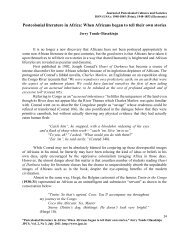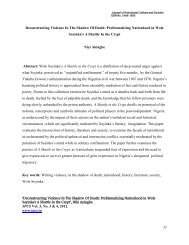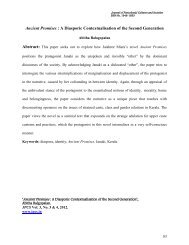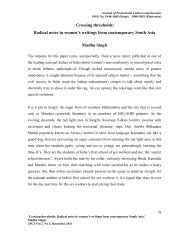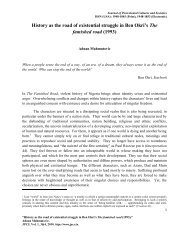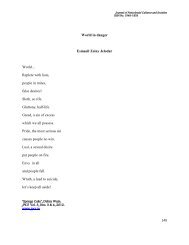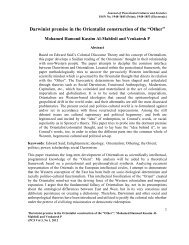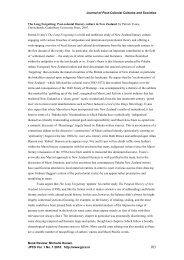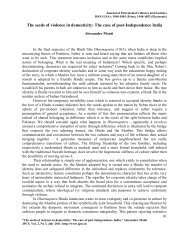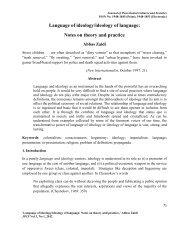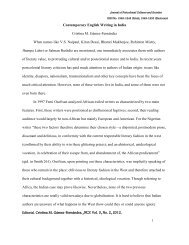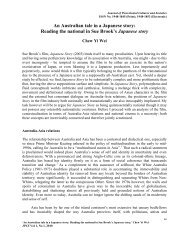'Caste as a Social Construct in Indira Goswami's The Moth ... - JPCS
'Caste as a Social Construct in Indira Goswami's The Moth ... - JPCS
'Caste as a Social Construct in Indira Goswami's The Moth ... - JPCS
You also want an ePaper? Increase the reach of your titles
YUMPU automatically turns print PDFs into web optimized ePapers that Google loves.
Journal of Postcolonial Cultures and Societies<br />
ISSN No. 1948-1845 (Pr<strong>in</strong>t); 1948-1853 (Electronic)<br />
C<strong>as</strong>te <strong>as</strong> a <strong>Social</strong> <strong>Construct</strong> <strong>in</strong> <strong>Indira</strong> Goswami’s <strong>The</strong> <strong>Moth</strong>-Eaten Howdah of the Tusker<br />
and “<strong>The</strong> Offspr<strong>in</strong>g”<br />
Kumar Sankar Bhattacharya<br />
Abstract: Us<strong>in</strong>g <strong>Indira</strong> Goswami’s literary works like <strong>The</strong> <strong>Moth</strong>-Eaten Howdah of the Tusker<br />
and “<strong>The</strong> Offspr<strong>in</strong>g,” this essay explores the disabilities and functionalities of region-specific<br />
c<strong>as</strong>te system <strong>in</strong> India. As it analyzes the complex nuances of marg<strong>in</strong>ality <strong>in</strong> terms of c<strong>as</strong>te, it also<br />
reveals the complementary nature of c<strong>as</strong>te and cl<strong>as</strong>s <strong>in</strong> certa<strong>in</strong> c<strong>as</strong>es <strong>as</strong> Goswami h<strong>as</strong><br />
demonstrated, that leads to unique identity formation at multiple levels.<br />
Keywords: c<strong>as</strong>te, India, <strong>Indira</strong> Goswami, untouchability, marg<strong>in</strong>ality<br />
‘C<strong>as</strong>te <strong>as</strong> a <strong>Social</strong> <strong>Construct</strong> <strong>in</strong> <strong>Indira</strong> Goswami’s <strong>The</strong> <strong>Moth</strong>-Eaten Howdah of the Tusker and<br />
“<strong>The</strong> Offspr<strong>in</strong>g”, Kumar Sankar Bhattacharya.<br />
<strong>JPCS</strong> Vol. 3, No. 2, 2012.<br />
www.jpcs.<strong>in</strong><br />
9
Journal of Postcolonial Cultures and Societies<br />
ISSN No. 1948-1845 (Pr<strong>in</strong>t); 1948-1853 (Electronic)<br />
C<strong>as</strong>te <strong>as</strong> a <strong>Social</strong> <strong>Construct</strong> <strong>in</strong> <strong>Indira</strong> Goswami’s <strong>The</strong> <strong>Moth</strong>-Eaten Howdah of the Tusker<br />
and “<strong>The</strong> Offspr<strong>in</strong>g”<br />
Kumar Sankar Bhattacharya<br />
Storyteller, novelist, w<strong>in</strong>ner of the Jnanpith award and the Sahitya Akademi award, <strong>Indira</strong><br />
Goswami (also known <strong>as</strong> Mamoni Raisom Goswami) is one of the most em<strong>in</strong>ent writers from<br />
North-E<strong>as</strong>t India. A versatile writer over the l<strong>as</strong>t several years, she h<strong>as</strong> received numerous<br />
accolades all over the world. Her contributions are much more than mere literary achievements.<br />
She <strong>in</strong>corporates <strong>in</strong> her writ<strong>in</strong>gs her hope for justice and equality that reflects her deep<br />
connections with society.<br />
<strong>Indira</strong> Goswami’s writ<strong>in</strong>gs, while narrat<strong>in</strong>g simple anecdotes, show her deep empathy for<br />
the marg<strong>in</strong>als of society. Although Goswami w<strong>as</strong> born <strong>in</strong> a Brahm<strong>in</strong> family, <strong>as</strong> a woman, she h<strong>as</strong><br />
experienced the restrictions and constrictions of her conservative society. Her widowhood after<br />
only two years of marriage, and her subsequent suffer<strong>in</strong>gs, <strong>in</strong>tensify her sensitivity towards the<br />
victims of social and <strong>in</strong>dividual oppression. Due to her personal suffer<strong>in</strong>gs, Goswami<br />
understands the plight of those liv<strong>in</strong>g <strong>in</strong> the periphery and her sympathy for such victims<br />
translates <strong>in</strong>to touch<strong>in</strong>g sag<strong>as</strong> of the people <strong>in</strong> and around her life.<br />
However, while retell<strong>in</strong>g the stories of the suffer<strong>in</strong>g marg<strong>in</strong>als, Goswami consciously<br />
avoids the risk of stereotyp<strong>in</strong>g and homogeniz<strong>in</strong>g such isolated characters. Her writ<strong>in</strong>gs reflect<br />
the awareness that, because of the tremendous diversity of the population and the complexity of<br />
survival, marg<strong>in</strong>alization <strong>in</strong> India takes place at different levels and cannot be rigidly<br />
compartmentalized <strong>in</strong>to fixed categories and simple b<strong>in</strong>aries such <strong>as</strong> the “dom<strong>in</strong>ant” and the<br />
“marg<strong>in</strong>al.” <strong>The</strong>se attributes, <strong>as</strong> Goswami demonstrates, are <strong>in</strong>terchangeable <strong>in</strong> different social<br />
‘C<strong>as</strong>te <strong>as</strong> a <strong>Social</strong> <strong>Construct</strong> <strong>in</strong> <strong>Indira</strong> Goswami’s <strong>The</strong> <strong>Moth</strong>-Eaten Howdah of the Tusker and<br />
“<strong>The</strong> Offspr<strong>in</strong>g”, Kumar Sankar Bhattacharya.<br />
<strong>JPCS</strong> Vol. 3, No. 2, 2012.<br />
www.jpcs.<strong>in</strong><br />
10
Journal of Postcolonial Cultures and Societies<br />
ISSN No. 1948-1845 (Pr<strong>in</strong>t); 1948-1853 (Electronic)<br />
sett<strong>in</strong>gs. This essay explores how <strong>Indira</strong> Goswami depicts the complex nuances of marg<strong>in</strong>ality <strong>in</strong><br />
terms of c<strong>as</strong>te through her writ<strong>in</strong>gs. While delv<strong>in</strong>g on Goswami’s exploration of the identities,<br />
disabilities and functionalities of region-specific c<strong>as</strong>te system, attention is also drawn to specific<br />
c<strong>as</strong>es where both cl<strong>as</strong>s and c<strong>as</strong>te become complementary and <strong>in</strong>tertw<strong>in</strong>e closely to make up<br />
unique social identities.<br />
C<strong>as</strong>te <strong>in</strong> the Indian context is always very complicated and dist<strong>in</strong>ct <strong>as</strong> it functions<br />
diversely among different groups <strong>in</strong> different regions. Like its theory of orig<strong>in</strong>, c<strong>as</strong>te is def<strong>in</strong>itely<br />
plural <strong>in</strong> nature <strong>in</strong> India for it depends broadly on local <strong>as</strong>pects. While discuss<strong>in</strong>g the orig<strong>in</strong> of<br />
c<strong>as</strong>te, A. P. Barnab<strong>as</strong> and Subh<strong>as</strong>h C. Mehta <strong>in</strong> C<strong>as</strong>te <strong>in</strong> Chang<strong>in</strong>g India aptly comment on the<br />
plurality of the c<strong>as</strong>te theories:<br />
. . . there are so many theories on the orig<strong>in</strong> of the c<strong>as</strong>te system <strong>in</strong> India—some<br />
seek<strong>in</strong>g its roots primarily <strong>in</strong> the racial and ethnic differences, some <strong>in</strong> the socio-<br />
spiritual evolution of the tribal characteristics of India <strong>in</strong> ancient times, some only<br />
<strong>in</strong> the occupational differences, some merely <strong>in</strong> the spiritual beliefs of the pre-<br />
Aryans and Aryans <strong>in</strong> India and so forth. It is likely that several factors work<strong>in</strong>g<br />
jo<strong>in</strong>tly led <strong>in</strong> course of time to the emergence of the Indian c<strong>as</strong>te system, its<br />
social, economic and ideological facets be<strong>in</strong>g specifically <strong>in</strong>fluenced by several<br />
factors. (10)<br />
Similar to Barnab<strong>as</strong> and Mehta, Andre Beteille <strong>in</strong> “Race, C<strong>as</strong>te and Ethnic Identity” observes the<br />
plurality and the complexity of the Indian c<strong>as</strong>te structure:<br />
In India it is not at all uncommon for a s<strong>in</strong>gle village to have <strong>as</strong> many <strong>as</strong> twenty or<br />
thirty c<strong>as</strong>tes. Each l<strong>in</strong>guistic region <strong>in</strong> the country h<strong>as</strong> between 200 and 300<br />
‘C<strong>as</strong>te <strong>as</strong> a <strong>Social</strong> <strong>Construct</strong> <strong>in</strong> <strong>Indira</strong> Goswami’s <strong>The</strong> <strong>Moth</strong>-Eaten Howdah of the Tusker and<br />
“<strong>The</strong> Offspr<strong>in</strong>g”, Kumar Sankar Bhattacharya.<br />
<strong>JPCS</strong> Vol. 3, No. 2, 2012.<br />
www.jpcs.<strong>in</strong><br />
11
Journal of Postcolonial Cultures and Societies<br />
ISSN No. 1948-1845 (Pr<strong>in</strong>t); 1948-1853 (Electronic)<br />
c<strong>as</strong>tes. Many of these are divided <strong>in</strong>to sub-c<strong>as</strong>tes which might <strong>in</strong> turn be further<br />
subdivided. If we leave the village and take a larger territorial unit, it becomes<br />
impossible even to determ<strong>in</strong>e the exact number of c<strong>as</strong>tes <strong>in</strong> it. <strong>The</strong> dist<strong>in</strong>ctions<br />
between c<strong>as</strong>te, sub-c<strong>as</strong>te and sub-sub-c<strong>as</strong>te become blurred. <strong>The</strong> same c<strong>as</strong>te might<br />
be called by different names and different c<strong>as</strong>tes by the same name. (133)<br />
From the theories mentioned above, it can be concluded that the c<strong>as</strong>te system <strong>in</strong> India<br />
operates at a very local level with each region hav<strong>in</strong>g its own way of form<strong>in</strong>g and susta<strong>in</strong><strong>in</strong>g<br />
c<strong>as</strong>te-b<strong>as</strong>ed societies. Cl<strong>as</strong>s also plays an important role <strong>in</strong> further complicat<strong>in</strong>g such dist<strong>in</strong>ctive<br />
and localized forms of the c<strong>as</strong>te system. While traditionally and historically Indian societies are<br />
seen to be more representative of the c<strong>as</strong>te system, the important role of cl<strong>as</strong>s <strong>in</strong> shap<strong>in</strong>g India’s<br />
social fabric usually rema<strong>in</strong>s unacknowledged. More importance is generally given to c<strong>as</strong>te <strong>as</strong><br />
the primary agent <strong>in</strong> def<strong>in</strong><strong>in</strong>g identities with<strong>in</strong> Indian communities and the role of cl<strong>as</strong>s structure<br />
with<strong>in</strong> them is almost always ignored. In certa<strong>in</strong> c<strong>as</strong>es, <strong>as</strong> Goswami shows, cl<strong>as</strong>s and c<strong>as</strong>te<br />
comb<strong>in</strong>e to form more complex identities at multiple levels.<br />
As stated at the beg<strong>in</strong>n<strong>in</strong>g of this essay, c<strong>as</strong>te <strong>as</strong> a system of <strong>in</strong>equality h<strong>as</strong> no fixed<br />
pattern of operation <strong>in</strong> India. It is a highly localized phenomenon and varies from region to<br />
region. However, there are certa<strong>in</strong> b<strong>as</strong>ic features that are common to any c<strong>as</strong>te system operat<strong>in</strong>g<br />
at any local level. Paul<strong>in</strong>e Kolenda, <strong>in</strong> C<strong>as</strong>te <strong>in</strong> Contemporary India: Beyond Organic Solidarity<br />
elaborates some of the characteristics and the operation of an <strong>in</strong>tr<strong>in</strong>sically localized c<strong>as</strong>te system<br />
with<strong>in</strong> limited boundaries of a s<strong>in</strong>gle place or a few l<strong>in</strong>ked places. Kolenda notices that almost <strong>in</strong><br />
all c<strong>as</strong>es, “a dom<strong>in</strong>ant c<strong>as</strong>te, or a dom<strong>in</strong>ant family, or a set of families, typically h<strong>as</strong> preponderant<br />
political and economic power over everyone else <strong>in</strong> the locality” (40). Such dom<strong>in</strong>ance rises<br />
‘C<strong>as</strong>te <strong>as</strong> a <strong>Social</strong> <strong>Construct</strong> <strong>in</strong> <strong>Indira</strong> Goswami’s <strong>The</strong> <strong>Moth</strong>-Eaten Howdah of the Tusker and<br />
“<strong>The</strong> Offspr<strong>in</strong>g”, Kumar Sankar Bhattacharya.<br />
<strong>JPCS</strong> Vol. 3, No. 2, 2012.<br />
www.jpcs.<strong>in</strong><br />
12
Journal of Postcolonial Cultures and Societies<br />
ISSN No. 1948-1845 (Pr<strong>in</strong>t); 1948-1853 (Electronic)<br />
from the family’s “monopolistic control over arable land and <strong>in</strong> physical force” (40) and gives<br />
that family absolute power to get maximum benefit from the system. Although the c<strong>as</strong>tes are<br />
<strong>in</strong>terdependent <strong>in</strong> provid<strong>in</strong>g service to each other, the system functions <strong>in</strong> such a way that the<br />
“purity” of the higher c<strong>as</strong>tes is always ma<strong>in</strong>ta<strong>in</strong>ed:<br />
Each c<strong>as</strong>te h<strong>as</strong> an occupational specialty, and offers this to other c<strong>as</strong>tes <strong>in</strong><br />
exchange for food, products or services. Especially important is the food gra<strong>in</strong><br />
provided by the land-controll<strong>in</strong>g c<strong>as</strong>te or families to the landless servant, artisan,<br />
and mendicant c<strong>as</strong>tes. This exchange of food, goods and services is a ritual<br />
system concerned with purity and pollution <strong>as</strong> well <strong>as</strong> an economic system. Called<br />
the jajmani system it functions so that the higher c<strong>as</strong>tes rema<strong>in</strong> pure while the<br />
lower c<strong>as</strong>tes absorb pollution for them. (40-41)<br />
Goswami’s novel, <strong>The</strong> <strong>Moth</strong>-Eaten Howdah of the Tusker (2004) <strong>in</strong>corporates such c<strong>as</strong>te<br />
features at a local level and operates along similar c<strong>as</strong>te dynamics.<br />
This novel h<strong>as</strong> multiple themes. Among them, one of the strongest is its deal<strong>in</strong>g with the<br />
c<strong>as</strong>te hierarchy. Goswami’s portrayal of the Gossa<strong>in</strong> family demonstrates the operations of c<strong>as</strong>te<br />
theories with<strong>in</strong> the Gossa<strong>in</strong> sattra 1 where steps are taken to ma<strong>in</strong>ta<strong>in</strong> the “purity” vis-à-vis the<br />
“polluted” lower c<strong>as</strong>tes. As the spiritual head of the sattra, Gossa<strong>in</strong> is undoubtedly very powerful<br />
with<strong>in</strong> the community. To supplement his superior spiritual stand<strong>in</strong>g, he h<strong>as</strong> “extensive feudal<br />
landed property” (<strong>The</strong> <strong>Moth</strong>-Eaten 349) that also gives him economic and social authority over<br />
the people of the sattra. <strong>The</strong> operation and sustenance of the Gossa<strong>in</strong> family form typical<br />
examples of Kolenda’s local c<strong>as</strong>te theory; the lower c<strong>as</strong>te people with<strong>in</strong> the sattra are subservient<br />
to the Gossa<strong>in</strong> family and offer services <strong>in</strong> exchange for food and spiritual guidance.<br />
‘C<strong>as</strong>te <strong>as</strong> a <strong>Social</strong> <strong>Construct</strong> <strong>in</strong> <strong>Indira</strong> Goswami’s <strong>The</strong> <strong>Moth</strong>-Eaten Howdah of the Tusker and<br />
“<strong>The</strong> Offspr<strong>in</strong>g”, Kumar Sankar Bhattacharya.<br />
<strong>JPCS</strong> Vol. 3, No. 2, 2012.<br />
www.jpcs.<strong>in</strong><br />
13
Journal of Postcolonial Cultures and Societies<br />
ISSN No. 1948-1845 (Pr<strong>in</strong>t); 1948-1853 (Electronic)<br />
Traditionally the Gossa<strong>in</strong>s, for generations, have played the role of patrons by br<strong>in</strong>g<strong>in</strong>g lower<br />
c<strong>as</strong>te people from different are<strong>as</strong> and help<strong>in</strong>g them to settle <strong>in</strong> their sattra. Because these people<br />
have different occupations, they ensure that the Gossa<strong>in</strong> family h<strong>as</strong> its needs fulfilled all the<br />
time. Goswami gives an idea of various lower c<strong>as</strong>te people with<strong>in</strong> the sattra <strong>as</strong> she describes<br />
Indranath’s journey to Marabhitha. As Indranath, the future Adhikar (ruler) of the sattra goes to<br />
Marabhitha to <strong>as</strong>sert his feudal rights and power over the communists, his procession p<strong>as</strong>ses by a<br />
cheer<strong>in</strong>g group of people of different c<strong>as</strong>tes l<strong>in</strong><strong>in</strong>g the street. <strong>The</strong>y are people who mostly belong<br />
to the lower c<strong>as</strong>tes—kahars (makers of br<strong>as</strong>s and copper utensils), kamars (blacksmiths), badhais<br />
(carpenters), napits (barbers), dhubis (w<strong>as</strong>hermen), and dhuli<strong>as</strong> (palanqu<strong>in</strong> bearers). <strong>The</strong>y live on<br />
the periphery of the sattra and serve the Gossa<strong>in</strong> family <strong>in</strong> one capacity or other.<br />
Despite all the services that the lower c<strong>as</strong>te people provide to the Gossa<strong>in</strong>s and other<br />
higher c<strong>as</strong>tes, the lower c<strong>as</strong>tes are never treated with respect. Goswami shows <strong>in</strong> the course of<br />
the novel that the higher c<strong>as</strong>tes steadf<strong>as</strong>tly ma<strong>in</strong>ta<strong>in</strong> distance from the lower c<strong>as</strong>tes to avoid be<strong>in</strong>g<br />
polluted by touch. She gives frequent descriptions of <strong>in</strong>cidents where the upper c<strong>as</strong>tes’ obsession<br />
with their purity dehumanizes and stigmatizes the lower c<strong>as</strong>tes. For <strong>in</strong>stance, Goswami describes<br />
how all the Gossa<strong>in</strong> family servants and the workers <strong>in</strong> the fields do not have access <strong>in</strong>side the<br />
Gossa<strong>in</strong> household <strong>as</strong> they belong to the lower c<strong>as</strong>tes. Likewise, people belong<strong>in</strong>g to a different<br />
religion or foreigners are considered impure <strong>in</strong> the c<strong>as</strong>te hierarchy with<strong>in</strong> the Gossa<strong>in</strong> sattra and<br />
are also not allowed to enter the <strong>in</strong>ner chambers of the house. In the novel, the upper c<strong>as</strong>tes are <strong>in</strong><br />
perpetual fear of be<strong>in</strong>g contam<strong>in</strong>ated and the Gossa<strong>in</strong>s, along with other Brahm<strong>in</strong>s belong<strong>in</strong>g to<br />
higher c<strong>as</strong>tes, make conscious efforts to ma<strong>in</strong>ta<strong>in</strong> their purity by avoid<strong>in</strong>g the touch of lower<br />
c<strong>as</strong>te people.<br />
‘C<strong>as</strong>te <strong>as</strong> a <strong>Social</strong> <strong>Construct</strong> <strong>in</strong> <strong>Indira</strong> Goswami’s <strong>The</strong> <strong>Moth</strong>-Eaten Howdah of the Tusker and<br />
“<strong>The</strong> Offspr<strong>in</strong>g”, Kumar Sankar Bhattacharya.<br />
<strong>JPCS</strong> Vol. 3, No. 2, 2012.<br />
www.jpcs.<strong>in</strong><br />
14
Journal of Postcolonial Cultures and Societies<br />
ISSN No. 1948-1845 (Pr<strong>in</strong>t); 1948-1853 (Electronic)<br />
Goswami portrays several <strong>in</strong>cidents <strong>in</strong> the novel where this fear of contam<strong>in</strong>ation is so<br />
extreme on the part of the upper c<strong>as</strong>te people that it almost seems comic <strong>in</strong> the end. In one such<br />
c<strong>as</strong>e, Goswami describes the visit of Mark Sahib to the Gossa<strong>in</strong> family house. Mark Sahib comes<br />
to do research work on Assamese sattra and needs a place to stay. He is aware of his othered<br />
stature <strong>as</strong> a “fir<strong>in</strong>gi” (literally translated <strong>as</strong> a white man) and is happy that the Gossa<strong>in</strong> family lets<br />
him stay <strong>in</strong> a small hut <strong>in</strong> the elephants’ graz<strong>in</strong>g ground. When he enters the Gossa<strong>in</strong> house, he is<br />
made to sit on a wooden chair <strong>in</strong> the verandah <strong>as</strong> women of the house, Durga and Giribala, come<br />
out to meet him. Suddenly Durga f<strong>in</strong>ds to her horror that “Mark Sahib’s shadow . . . [h<strong>as</strong>] . . .<br />
fallen on her body” (<strong>The</strong> <strong>Moth</strong>-Eaten 65). Goswami writes <strong>in</strong> a mock serious tone, that it is<br />
<strong>in</strong>deed dangerous for a “fir<strong>in</strong>gi’s shadow” (<strong>The</strong> <strong>Moth</strong>-Eaten 65) to fall on a Gossa<strong>in</strong> widow <strong>as</strong> it<br />
makes Durga polluted. She h<strong>as</strong> to take a second bath to make herself clean once aga<strong>in</strong>. Later<br />
also, Mark Sahib faces such discrim<strong>in</strong>ation <strong>in</strong> the Gossa<strong>in</strong> household. As an “unclean” foreigner,<br />
Mark Sahib h<strong>as</strong> separate utensils <strong>in</strong> the Gossa<strong>in</strong> house for eat<strong>in</strong>g and dr<strong>in</strong>k<strong>in</strong>g. While visit<strong>in</strong>g the<br />
sattra on another occ<strong>as</strong>ion, Mark is offered food and dr<strong>in</strong>k by Durga. He observes how Durga<br />
avoids his shadow while serv<strong>in</strong>g him <strong>in</strong> a separate set of tumblers and bowls that are kept <strong>as</strong>ide<br />
<strong>in</strong> the dhekal room. 2<br />
Like Durga, the other members of the Gossa<strong>in</strong> family with the exception of Indranath, are<br />
also proponents of strict c<strong>as</strong>te hierarchy. Gossa<strong>in</strong>ee, Indranath’s mother, supports Durga <strong>as</strong> she<br />
cautions Indranath, the future Adhikar for mix<strong>in</strong>g freely with lower c<strong>as</strong>te people at Bolo’s den.<br />
<strong>The</strong>y compla<strong>in</strong> that such <strong>in</strong>termix<strong>in</strong>g is unbecom<strong>in</strong>g of Indranath’s position <strong>as</strong> the future Adhikar<br />
of the sattra, for it underm<strong>in</strong>es his superior c<strong>as</strong>te status. Even Indranath’s aunt Saru Gossa<strong>in</strong>ee,<br />
who is portrayed <strong>as</strong> somewhat progressive by Goswami, is no exception to this superior c<strong>as</strong>te<br />
‘C<strong>as</strong>te <strong>as</strong> a <strong>Social</strong> <strong>Construct</strong> <strong>in</strong> <strong>Indira</strong> Goswami’s <strong>The</strong> <strong>Moth</strong>-Eaten Howdah of the Tusker and<br />
“<strong>The</strong> Offspr<strong>in</strong>g”, Kumar Sankar Bhattacharya.<br />
<strong>JPCS</strong> Vol. 3, No. 2, 2012.<br />
www.jpcs.<strong>in</strong><br />
15
Journal of Postcolonial Cultures and Societies<br />
ISSN No. 1948-1845 (Pr<strong>in</strong>t); 1948-1853 (Electronic)<br />
complex. Though Saru Gossa<strong>in</strong>ee is a Gossa<strong>in</strong> widow, she takes liberty <strong>in</strong> certa<strong>in</strong> th<strong>in</strong>gs which<br />
others of similar background will never undertake. However, she is equally rigid like her other<br />
family members when it comes to c<strong>as</strong>te. Goswami describes an <strong>in</strong>cident where Durga quarrels<br />
with the Gossa<strong>in</strong>ee regard<strong>in</strong>g her pilgrimage. She wants her life’s sav<strong>in</strong>gs from the Gossa<strong>in</strong>ee so<br />
that she can go to pilgrimage with other people. As both the women fight it out <strong>in</strong> the open, all<br />
lower c<strong>as</strong>te women from the neighborhood gather <strong>in</strong> the courtyard to see what appears unusual to<br />
them. Saru Gossa<strong>in</strong>ee is aware that such occurrences do not go well with the family’s prestige<br />
and status outside. When she tells the lower c<strong>as</strong>te women to leave, her contempt for them comes<br />
out. As she leads them out, she gets a “whiff of bad odor, like that of a rotten jack-fruit from the<br />
bodies of the women” (<strong>The</strong> <strong>Moth</strong>-Eaten 99) and quickly covers her nose with her dress.<br />
<strong>The</strong> concept of pollution is so deeply <strong>in</strong>gra<strong>in</strong>ed with<strong>in</strong> the Gossa<strong>in</strong> sattra that even a<br />
small, <strong>in</strong>nocent child cannot escape it. While describ<strong>in</strong>g Indranath’s childhood days, Goswami<br />
reveals how the c<strong>as</strong>te constantly determ<strong>in</strong>es and dist<strong>in</strong>guishes social boundaries with<strong>in</strong> the sattra.<br />
Dur<strong>in</strong>g his childhood days, Indranath is unaware of his higher c<strong>as</strong>te status and mixes freely with<br />
lower c<strong>as</strong>te children. He is ch<strong>as</strong>ed and caught by his aunt Durga only to be purified from the<br />
touch of lower c<strong>as</strong>te people:<br />
Many times, he would dodge the rigid rout<strong>in</strong>e of a Gossa<strong>in</strong>’s son, and run away to<br />
play with the children of fishermen, potters, cobblers, and the like, clad only <strong>in</strong> a<br />
gamucha 3 tied round his waist. Durga would run after him, to catch him, with<br />
scold<strong>in</strong>g words. (<strong>The</strong> <strong>Moth</strong>-Eaten 337)<br />
After catch<strong>in</strong>g Indranath, Durga hurriedly takes him to a well and w<strong>as</strong>hes him. <strong>The</strong> same<br />
happens to Giribala, Indranath’s sister. Giribala, <strong>as</strong> a child plays <strong>in</strong> the lap of their cart driver. As<br />
‘C<strong>as</strong>te <strong>as</strong> a <strong>Social</strong> <strong>Construct</strong> <strong>in</strong> <strong>Indira</strong> Goswami’s <strong>The</strong> <strong>Moth</strong>-Eaten Howdah of the Tusker and<br />
“<strong>The</strong> Offspr<strong>in</strong>g”, Kumar Sankar Bhattacharya.<br />
<strong>JPCS</strong> Vol. 3, No. 2, 2012.<br />
www.jpcs.<strong>in</strong><br />
16
Journal of Postcolonial Cultures and Societies<br />
ISSN No. 1948-1845 (Pr<strong>in</strong>t); 1948-1853 (Electronic)<br />
the cart driver belongs to the potter c<strong>as</strong>te, Giribala’s mother drags her away to “force the child to<br />
take a bath to purify her of the touch of a low-c<strong>as</strong>te man” (<strong>The</strong> <strong>Moth</strong>-Eaten 190).<br />
However, <strong>as</strong> Goswami shows, the c<strong>as</strong>te discrim<strong>in</strong>ation and untouchability go beyond<br />
simple purification rituals and become rigid <strong>in</strong> many c<strong>as</strong>es that result <strong>in</strong> a sharp decl<strong>in</strong>e <strong>in</strong> b<strong>as</strong>ic<br />
human comp<strong>as</strong>sion. She describes an <strong>in</strong>cident when Indranath h<strong>as</strong> to take a bath for sav<strong>in</strong>g a<br />
lower c<strong>as</strong>te child from imm<strong>in</strong>ent death. It is dur<strong>in</strong>g the time when Indranath is stay<strong>in</strong>g with his<br />
friend Devdutt and other high c<strong>as</strong>te Brahm<strong>in</strong> boys <strong>in</strong> the city of Guahati while pursu<strong>in</strong>g higher<br />
studies. <strong>The</strong> Gossa<strong>in</strong>s, because of their c<strong>as</strong>te, do not take food prepared by other lowly c<strong>as</strong>tes. So<br />
they cook their own food. On a December morn<strong>in</strong>g, a small boy from a fisherman’s c<strong>as</strong>te stops<br />
by to sell “kaoimach”, a small fresh water fish with bones and spikes. As the boy pours the live<br />
fishes on the floor, one of them manages to get <strong>in</strong>to the boy’s mouth and gets stuck <strong>in</strong> his throat.<br />
<strong>The</strong> boy is <strong>in</strong> <strong>in</strong>tense pa<strong>in</strong> and soon “start[s] vomit<strong>in</strong>g blood” (<strong>The</strong> <strong>Moth</strong>-Eaten 312). But nobody<br />
comes to his help <strong>as</strong> the high c<strong>as</strong>te people <strong>in</strong> the room have to take a second bath <strong>in</strong> cold<br />
December weather if they touch a low c<strong>as</strong>te person. Indranath, despite suffer<strong>in</strong>g from malaria<br />
and bedridden, jumps out of his bed, puts his hand <strong>in</strong>side the boy’s mouth and pulls the fish from<br />
his throat. <strong>The</strong> boy is saved, but, Indranath h<strong>as</strong> to take a bath to be purified after that. Through<br />
this <strong>in</strong>cident, Goswami takes a dig at the irrational c<strong>as</strong>te dist<strong>in</strong>ction. She questions the rigidity of<br />
the c<strong>as</strong>te system and shows its futility. While noth<strong>in</strong>g could be more precious than a human life,<br />
these so-called upper c<strong>as</strong>tes are obsessed with the vanity and rigidity of their superior c<strong>as</strong>te status<br />
and fail utterly <strong>as</strong> human be<strong>in</strong>gs.<br />
<strong>The</strong> above <strong>in</strong>cident shows that the paranoia of gett<strong>in</strong>g polluted from the lower c<strong>as</strong>tes is<br />
not an exclusive feature with<strong>in</strong> the Gossa<strong>in</strong> household <strong>as</strong> the majority of the so called upper c<strong>as</strong>te<br />
‘C<strong>as</strong>te <strong>as</strong> a <strong>Social</strong> <strong>Construct</strong> <strong>in</strong> <strong>Indira</strong> Goswami’s <strong>The</strong> <strong>Moth</strong>-Eaten Howdah of the Tusker and<br />
“<strong>The</strong> Offspr<strong>in</strong>g”, Kumar Sankar Bhattacharya.<br />
<strong>JPCS</strong> Vol. 3, No. 2, 2012.<br />
www.jpcs.<strong>in</strong><br />
17
Journal of Postcolonial Cultures and Societies<br />
ISSN No. 1948-1845 (Pr<strong>in</strong>t); 1948-1853 (Electronic)<br />
people <strong>in</strong> the novel demonstrate this obsession <strong>in</strong> their <strong>in</strong>teraction with the lower c<strong>as</strong>tes.<br />
Goswami further reveals how the other Brahm<strong>in</strong>s also behave like the Gossa<strong>in</strong> family members<br />
to save themselves from be<strong>in</strong>g polluted by the lower c<strong>as</strong>tes. One such character is the Gossa<strong>in</strong><br />
family priest, Purshottam Bhagwati, a Brahm<strong>in</strong> who is excessively aware of his upper c<strong>as</strong>te<br />
identity. Even <strong>in</strong> social gather<strong>in</strong>gs, he proactively ma<strong>in</strong>ta<strong>in</strong>s his superior position. Thus, <strong>in</strong> a<br />
meet<strong>in</strong>g at Bolo’s den Bhagwati shifts his chair to avoid the shadow of a low c<strong>as</strong>te person when<br />
he is <strong>in</strong>formed that the teacher sitt<strong>in</strong>g beside him belongs to the lowly Dom community. Such<br />
behavior shows contempt on Bhagwati’s part towards the lower c<strong>as</strong>tes that is also emulated by<br />
many other Brahm<strong>in</strong>s. Dur<strong>in</strong>g the shraddha ceremony 4 for the older Gossa<strong>in</strong>, Giribala, the<br />
widowed daughter of the Gossa<strong>in</strong> family, almost comically notices the “pitiable state of the old<br />
Brahm<strong>in</strong> servers” (<strong>The</strong> <strong>Moth</strong>-Eaten 137-8) serv<strong>in</strong>g food to the lower c<strong>as</strong>te poor people who have<br />
gathered for the fe<strong>as</strong>t. <strong>The</strong>se Brahm<strong>in</strong> servers while giv<strong>in</strong>g out food awkwardly run around<br />
tak<strong>in</strong>g all precautions so that they can avoid the touch of “the excited hands of the children” (<strong>The</strong><br />
<strong>Moth</strong>-Eaten 138).<br />
As Goswami reveals an <strong>in</strong>herent discrim<strong>in</strong>ation <strong>in</strong> the c<strong>as</strong>te system that is exploited to the<br />
fullest by the upper c<strong>as</strong>te members of society, she also demonstrates the <strong>in</strong>ability of the lower<br />
c<strong>as</strong>tes to fight aga<strong>in</strong>st this apartheid. <strong>The</strong> lower c<strong>as</strong>tes, <strong>in</strong> many c<strong>as</strong>es, take c<strong>as</strong>te hierarchy <strong>as</strong> the<br />
natural order of th<strong>in</strong>gs and rema<strong>in</strong> subservient to the upper c<strong>as</strong>te people without question<strong>in</strong>g the<br />
<strong>in</strong>equity. All social agencies work <strong>in</strong> tandem also to uphold the c<strong>as</strong>te hierarchy and tra<strong>in</strong> the<br />
lower c<strong>as</strong>tes to accept their <strong>in</strong>ferior position <strong>in</strong> society automatically. Ghanshyam Shah <strong>in</strong><br />
Movements <strong>in</strong> India: A Review of Literature, while expla<strong>in</strong><strong>in</strong>g how this process of subservience<br />
works with the lower c<strong>as</strong>tes, comments:<br />
‘C<strong>as</strong>te <strong>as</strong> a <strong>Social</strong> <strong>Construct</strong> <strong>in</strong> <strong>Indira</strong> Goswami’s <strong>The</strong> <strong>Moth</strong>-Eaten Howdah of the Tusker and<br />
“<strong>The</strong> Offspr<strong>in</strong>g”, Kumar Sankar Bhattacharya.<br />
<strong>JPCS</strong> Vol. 3, No. 2, 2012.<br />
www.jpcs.<strong>in</strong><br />
18
Journal of Postcolonial Cultures and Societies<br />
ISSN No. 1948-1845 (Pr<strong>in</strong>t); 1948-1853 (Electronic)<br />
In the c<strong>as</strong>te system, the <strong>in</strong>dividual’s duty to the c<strong>as</strong>te system w<strong>as</strong> emph<strong>as</strong>ized, not<br />
his rights with<strong>in</strong> the society. <strong>The</strong> lower c<strong>as</strong>tes were taught to accept their place <strong>in</strong><br />
the social order, so <strong>as</strong> to obta<strong>in</strong> a better position <strong>in</strong> the next life through religious<br />
ceremonies and rituals. (37)<br />
Thus, the lower c<strong>as</strong>tes are made to feel that they are responsible for their <strong>in</strong>ferior and<br />
disadvantaged positions <strong>in</strong> society. As they are born <strong>in</strong>to their c<strong>as</strong>tes and this cannot be undone,<br />
they have to accept it. However, if they cont<strong>in</strong>ue to do good works by serv<strong>in</strong>g the upper c<strong>as</strong>tes<br />
and their needs, rigidly follow<strong>in</strong>g social rituals and customs regard<strong>in</strong>g pollution, then there are<br />
chances of rewards <strong>in</strong> their next life when they can be born <strong>in</strong>to higher c<strong>as</strong>tes.<br />
In expla<strong>in</strong><strong>in</strong>g the behavior of the lower c<strong>as</strong>te people <strong>in</strong> the novel, Goswami <strong>in</strong>directly<br />
refers to this powerful ideology of c<strong>as</strong>te hierarchy mentioned above. As the Gossa<strong>in</strong> sattra uses<br />
its set of rules and regulations to effectively control and manipulate lower rung people <strong>in</strong> c<strong>as</strong>te<br />
hierarchy, the lower c<strong>as</strong>tes seldom have any other option but to respond to the demands and<br />
whims of socially superior people. Braj Ranjan Mani terms this controll<strong>in</strong>g set of rules and<br />
regulations <strong>as</strong> “Brahmanism” (15) <strong>in</strong> a different context. In Debrahmanis<strong>in</strong>g History:<br />
Dom<strong>in</strong>ance and Resistance <strong>in</strong> Indian Society, Mani describes it <strong>as</strong> an ideology that “stands for<br />
the aggregate of sacerdotal literature, social structure and religio-political <strong>in</strong>stitutions that have<br />
been m<strong>as</strong>term<strong>in</strong>ded by the elite with the primary aim of keep<strong>in</strong>g the m<strong>as</strong>ses ignorant, servile and<br />
disunited” (15). <strong>The</strong> <strong>in</strong>fluence of this “Brahmanism” is deep, <strong>as</strong> Goswami shows, with<strong>in</strong> the<br />
majority of lower c<strong>as</strong>te people <strong>in</strong> the novel. <strong>The</strong>y take their positions with<strong>in</strong> society <strong>as</strong><br />
preorda<strong>in</strong>ed and <strong>in</strong>advertently help to ma<strong>in</strong>ta<strong>in</strong> a strong hierarchy. In many c<strong>as</strong>es, the lower<br />
c<strong>as</strong>tes <strong>in</strong>ternalize the nuances of c<strong>as</strong>te system to such an extent that they become vanguards of<br />
‘C<strong>as</strong>te <strong>as</strong> a <strong>Social</strong> <strong>Construct</strong> <strong>in</strong> <strong>Indira</strong> Goswami’s <strong>The</strong> <strong>Moth</strong>-Eaten Howdah of the Tusker and<br />
“<strong>The</strong> Offspr<strong>in</strong>g”, Kumar Sankar Bhattacharya.<br />
<strong>JPCS</strong> Vol. 3, No. 2, 2012.<br />
www.jpcs.<strong>in</strong><br />
19
Journal of Postcolonial Cultures and Societies<br />
ISSN No. 1948-1845 (Pr<strong>in</strong>t); 1948-1853 (Electronic)<br />
this discrim<strong>in</strong>atory practice and condemn any deviation from the norm. Giribala experiences this<br />
<strong>in</strong> one <strong>in</strong>stance. Once while return<strong>in</strong>g from her friend’s house, Giribala stops mid-way and visits<br />
a long abandoned, dilapidated house with Mark Sahib. <strong>The</strong> cart driver is very disturbed by<br />
Giribala’s behavior <strong>as</strong>, for him, it is extremely unusual for “a highly respected Gossa<strong>in</strong> family’s<br />
widow . . . [to] . . . venture out alone with an unclean low-c<strong>as</strong>te Christian” (<strong>The</strong> <strong>Moth</strong>-Eaten<br />
190). Ironically, the cart driver belongs to the potter c<strong>as</strong>te, who w<strong>as</strong> discrim<strong>in</strong>ated aga<strong>in</strong>st for his<br />
low c<strong>as</strong>te earlier. He remembers how baby Giribala, the Gossa<strong>in</strong> daughter w<strong>as</strong> given a<br />
purification bath by her mother when he picked her up <strong>as</strong> a child. But he still fails to understand<br />
how Giribala can give up her family prestige and mixes freely with the “fir<strong>in</strong>gi” Mark. Like<br />
Giribala, her brother Indranath encounters similar <strong>in</strong>cidents. As a child, Indranath visits Kowria’s<br />
house and goes “runn<strong>in</strong>g right up to the cook<strong>in</strong>g stove of Kowria’s ramshackle hut” (<strong>The</strong> <strong>Moth</strong>-<br />
Eaten 338). Kowria’s wife cries out <strong>in</strong> horror that the Gossa<strong>in</strong>’s son h<strong>as</strong> come right <strong>in</strong>side<br />
without th<strong>in</strong>k<strong>in</strong>g about their low c<strong>as</strong>te and what will other people th<strong>in</strong>k about this untoward<br />
<strong>in</strong>cident. In the same way, Indranath’s visit <strong>as</strong> a child to the potter’s place <strong>in</strong> a locality called<br />
Tallapara creates une<strong>as</strong><strong>in</strong>ess among the potter’s family members. Indranath loves to see the<br />
potter at work and sometimes playfully “fl<strong>in</strong>g[s] his arms round the potter’s neck and climb[s] on<br />
to his back” (338). <strong>The</strong> potter exclaims <strong>in</strong> disgust that Indranath h<strong>as</strong> to take a bath for touch<strong>in</strong>g<br />
him.<br />
While the <strong>in</strong>ternalization of the c<strong>as</strong>te hierarchy by lower c<strong>as</strong>te people and scriptural<br />
sanctions along with the ideology of “Brahmanism” help the upper c<strong>as</strong>tes to enforce c<strong>as</strong>te<br />
discrim<strong>in</strong>ation, Goswami shows how the upper c<strong>as</strong>tes control and manipulate c<strong>as</strong>te dynamics by<br />
deliberately ma<strong>in</strong>ta<strong>in</strong><strong>in</strong>g a distance from the lower c<strong>as</strong>tes and discourag<strong>in</strong>g any free <strong>in</strong>ter-c<strong>as</strong>te<br />
‘C<strong>as</strong>te <strong>as</strong> a <strong>Social</strong> <strong>Construct</strong> <strong>in</strong> <strong>Indira</strong> Goswami’s <strong>The</strong> <strong>Moth</strong>-Eaten Howdah of the Tusker and<br />
“<strong>The</strong> Offspr<strong>in</strong>g”, Kumar Sankar Bhattacharya.<br />
<strong>JPCS</strong> Vol. 3, No. 2, 2012.<br />
www.jpcs.<strong>in</strong><br />
20
Journal of Postcolonial Cultures and Societies<br />
ISSN No. 1948-1845 (Pr<strong>in</strong>t); 1948-1853 (Electronic)<br />
mix<strong>in</strong>g whatsoever. <strong>The</strong> upper c<strong>as</strong>tes consciously cultivate a “hard-to-get” image that<br />
accentuates their stand<strong>in</strong>g among the common m<strong>as</strong>ses and imposes an aura around them that is<br />
difficult to expla<strong>in</strong>. <strong>The</strong>y are revered and given superhuman status by lower c<strong>as</strong>tes, who feel<br />
fortunate if they have a member of an upper c<strong>as</strong>te visit<strong>in</strong>g them. Indranath’s visit to the potter’s<br />
village <strong>as</strong> a child bears testimony to this culture of veneration among the lower c<strong>as</strong>tes. His visit<br />
evokes a sense of awe and reverence, even among children:<br />
<strong>The</strong> rickety, pot-bellied, half-naked children of the potter’s village used to gather<br />
round him and stare at him silently. Normally when they were by themselves,<br />
there would be a noise scuffle for gett<strong>in</strong>g hold of the cucumber. But <strong>in</strong> the<br />
presence of Indranath, they stood quietly <strong>as</strong> if they would give up their everyth<strong>in</strong>g<br />
to this son of the Gossa<strong>in</strong>. <strong>The</strong>y were struck dumb by the sight of this fair boy,<br />
with an undef<strong>in</strong>ed feel<strong>in</strong>g of utter amazement that they could not fathom. (<strong>The</strong><br />
<strong>Moth</strong>-Eaten 338)<br />
Indranath also gets the same k<strong>in</strong>d of super-hero treatment among the ramshackle huts of shuris,<br />
another low c<strong>as</strong>te. In spite of their “debilitat<strong>in</strong>g poverty” (<strong>The</strong> <strong>Moth</strong>-Eaten 339), these<br />
“untouchables” (<strong>The</strong> <strong>Moth</strong>-Eaten 339) treat Indranath <strong>as</strong> a god dur<strong>in</strong>g his occ<strong>as</strong>ional visits: “Yes,<br />
they really thought that the Gossa<strong>in</strong>s had descended from heaven. <strong>The</strong>y dared not touch a<br />
Gossa<strong>in</strong>, even a mere boy like him. And when they were on the threshold of death, they had a<br />
keen desire to touch a Gossa<strong>in</strong>’s feet” (<strong>The</strong> <strong>Moth</strong>-Eaten 339).<br />
Goswami portrays c<strong>as</strong>te discrim<strong>in</strong>ation and the concept of pollution and untouchability <strong>in</strong><br />
the novel <strong>as</strong> deplorable social malaises; but such prejudices slide further and reach an extreme<br />
po<strong>in</strong>t <strong>in</strong> her short story “<strong>The</strong> Offspr<strong>in</strong>g” from the collection titled <strong>The</strong> Shadow of Kamakhya:<br />
‘C<strong>as</strong>te <strong>as</strong> a <strong>Social</strong> <strong>Construct</strong> <strong>in</strong> <strong>Indira</strong> Goswami’s <strong>The</strong> <strong>Moth</strong>-Eaten Howdah of the Tusker and<br />
“<strong>The</strong> Offspr<strong>in</strong>g”, Kumar Sankar Bhattacharya.<br />
<strong>JPCS</strong> Vol. 3, No. 2, 2012.<br />
www.jpcs.<strong>in</strong><br />
21
Journal of Postcolonial Cultures and Societies<br />
ISSN No. 1948-1845 (Pr<strong>in</strong>t); 1948-1853 (Electronic)<br />
Stories by <strong>Indira</strong> Goswami (2001). Apparently the taboo of untouchability is broken <strong>in</strong> this story<br />
through the union between an upper and a lower c<strong>as</strong>te person; however, the union is for a<br />
utilitarian purpose only and the c<strong>as</strong>te dictum that separates the upper c<strong>as</strong>te and lower c<strong>as</strong>te gets<br />
re<strong>in</strong>forced <strong>in</strong> the end. <strong>The</strong> story <strong>in</strong>volves the trader Pitambar Mahajan and a Brahm<strong>in</strong> widow<br />
named Damayanti com<strong>in</strong>g together regardless of their different c<strong>as</strong>te stand<strong>in</strong>gs, out of their<br />
needs. Despite his material success, Pitambar is unhappy <strong>as</strong> he rema<strong>in</strong>s childless even after his<br />
second marriage. Damayanti, on the other hand, is a virtual destitute with two little daughters<br />
after her husband’s premature death, and lives “on the outer edge of the village” (<strong>The</strong> Shadow<br />
23). Although she belongs to the Bangara Brahm<strong>in</strong>s, known for their austerity and high c<strong>as</strong>te<br />
stand<strong>in</strong>g, she resorts to prostitution to get food for herself and her daughters after her<br />
widowhood.<br />
<strong>The</strong> story unfolds with Krishnakanta, the village priest visit<strong>in</strong>g Pitambar and<br />
sympathiz<strong>in</strong>g with him. Dur<strong>in</strong>g the course of the conversation, they see Damayanti com<strong>in</strong>g back<br />
from the Marwari merchants, a trader cl<strong>as</strong>s known for their bus<strong>in</strong>ess acumen. Krishnakanta<br />
suggests that s<strong>in</strong>ce Damayanti needs money and security, Pitambar can offer to marry her and get<br />
a child from her. He is <strong>as</strong>sured of a child from Damayanti <strong>as</strong> she h<strong>as</strong> earlier gone through four<br />
abortions <strong>in</strong>dicat<strong>in</strong>g her ability to bear a child unlike Pitambar’s two wives. Pitambar, however,<br />
is not sure whether Damayanti will agree to this proposal s<strong>in</strong>ce she belongs to the higher c<strong>as</strong>te.<br />
But Krishnakanta is quite confident because <strong>in</strong> recent times Brahm<strong>in</strong> girls are even marry<strong>in</strong>g<br />
fishermen and “the daughter of the Gossa<strong>in</strong> on the Dhaneshwari riverbank married a Muslim<br />
boy” (<strong>The</strong> Shadow 17). He takes responsibility of act<strong>in</strong>g <strong>as</strong> a go-between <strong>in</strong> lieu of money.<br />
‘C<strong>as</strong>te <strong>as</strong> a <strong>Social</strong> <strong>Construct</strong> <strong>in</strong> <strong>Indira</strong> Goswami’s <strong>The</strong> <strong>Moth</strong>-Eaten Howdah of the Tusker and<br />
“<strong>The</strong> Offspr<strong>in</strong>g”, Kumar Sankar Bhattacharya.<br />
<strong>JPCS</strong> Vol. 3, No. 2, 2012.<br />
www.jpcs.<strong>in</strong><br />
22
Journal of Postcolonial Cultures and Societies<br />
ISSN No. 1948-1845 (Pr<strong>in</strong>t); 1948-1853 (Electronic)<br />
However, <strong>as</strong> Goswami shows, that it is not e<strong>as</strong>y <strong>in</strong> the beg<strong>in</strong>n<strong>in</strong>g, for Damayanti is<br />
conscious about her c<strong>as</strong>te stand<strong>in</strong>g <strong>in</strong> spite of her poverty and does not want to “pollute” herself<br />
by means of a relationship with Pitambar. Once, while she is pluck<strong>in</strong>g green vegetables,<br />
Pitambar gathers all his courage and offers his help. But Damayanti gives him a look and<br />
Pitambar’s “eyes . . . [can] . . . not meet the <strong>in</strong>tense, disda<strong>in</strong>ful stare” (<strong>The</strong> Shadow 19). He<br />
hurriedly leaves the place. Even Krishnakanta’s first overtures have the same result. When<br />
Krishnakanta first tells Damayanti about Pitambar, she is “<strong>in</strong>furiated” (<strong>The</strong> Shadow 21). She<br />
spits out <strong>in</strong> anger and says that she will never have any relationship with the low c<strong>as</strong>te Pitambar:<br />
“That Pariah! How dare he send this proposal to me! Doesn’t he know that I am from the<br />
Jajamani Brahm<strong>in</strong> c<strong>as</strong>te and, he the verm<strong>in</strong>, is a low-c<strong>as</strong>te Mahajan?” (<strong>The</strong> Shadow 21).<br />
Damayanti cannot fathom how Krishnakanta, despite his high c<strong>as</strong>te stand<strong>in</strong>g, encourages and<br />
br<strong>in</strong>gs <strong>in</strong> that proposal. Goswami here reveals the false pride and ego of the widow regard<strong>in</strong>g her<br />
superior c<strong>as</strong>te stand<strong>in</strong>g. She can stoop low to prostitute herself, but she still th<strong>in</strong>ks that she is<br />
superior to the so-called lower c<strong>as</strong>te people.<br />
However, th<strong>in</strong>gs change altogether when Krishnakanta, threatens Damayanti and cajoles<br />
her with prospects of money and a secure life. She agrees to his proposal and Pitambar starts<br />
visit<strong>in</strong>g Damayanti regularly. Damayanti is giv<strong>in</strong>g herself to Pitambar for money, but she is still<br />
aware of her superior c<strong>as</strong>te stand<strong>in</strong>g and feels “unclean” after every encounter with Pitambar.<br />
<strong>The</strong> concept of be<strong>in</strong>g polluted drives her all the time and whenever they copulate, Damayanti<br />
will <strong>in</strong>variably take a bath to get purified from the touch of a lower c<strong>as</strong>te man.<br />
Damayanti’s egotistic sense of superiority is further demonstrated <strong>as</strong> she becomes<br />
pregnant. When Krishnakanta f<strong>in</strong>ds this out he immediately <strong>in</strong>forms Pitambar about it and vows<br />
‘C<strong>as</strong>te <strong>as</strong> a <strong>Social</strong> <strong>Construct</strong> <strong>in</strong> <strong>Indira</strong> Goswami’s <strong>The</strong> <strong>Moth</strong>-Eaten Howdah of the Tusker and<br />
“<strong>The</strong> Offspr<strong>in</strong>g”, Kumar Sankar Bhattacharya.<br />
<strong>JPCS</strong> Vol. 3, No. 2, 2012.<br />
www.jpcs.<strong>in</strong><br />
23
Journal of Postcolonial Cultures and Societies<br />
ISSN No. 1948-1845 (Pr<strong>in</strong>t); 1948-1853 (Electronic)<br />
to protect Damayanti’s pregnancy by mak<strong>in</strong>g sure that she can never go for an abortion. But,<br />
Damayanti <strong>in</strong> spite of all precautions taken by Krishnakanta gets “rid of the unborn child” (<strong>The</strong><br />
Shadow 29). She is a “Brahm<strong>in</strong> of Shandilyagotra” and, is not ready to “carry the seed of a low-<br />
c<strong>as</strong>te” (<strong>The</strong> Shadow 29). Whatever she h<strong>as</strong> agreed to, she h<strong>as</strong> to for pure economic re<strong>as</strong>ons. But<br />
she cannot, and will not, violate her c<strong>as</strong>te stand<strong>in</strong>g by begett<strong>in</strong>g a child from a low c<strong>as</strong>te person<br />
like Pitambar.<br />
While until now c<strong>as</strong>te discrim<strong>in</strong>ation <strong>in</strong> Goswami’s novel and short story h<strong>as</strong> been the<br />
focus of this essay, no observation regard<strong>in</strong>g her depiction of c<strong>as</strong>te is complete without referr<strong>in</strong>g<br />
to her portrayal of the upper c<strong>as</strong>te people <strong>in</strong> these works. In spite of be<strong>in</strong>g victims of social<br />
oppressions, lower c<strong>as</strong>te people are shown to be hardwork<strong>in</strong>g and honest. For Goswami, from<br />
moral and ethical perspectives, upper c<strong>as</strong>tes stand opposite to lower c<strong>as</strong>tes; often they are found<br />
to be manipulative and deceiv<strong>in</strong>g, and are seen to be constantly schem<strong>in</strong>g to make quick money.<br />
Though the c<strong>as</strong>te system is varied and complicated <strong>in</strong> the Indian context <strong>as</strong> mentioned<br />
above, it h<strong>as</strong> common ground<strong>in</strong>g and <strong>as</strong>sumption. <strong>The</strong> most universal and powerful <strong>as</strong>sumption<br />
perhaps is the superior status of the Brahm<strong>in</strong>s <strong>in</strong> the c<strong>as</strong>te hierarchy. <strong>The</strong>y occupy the central<br />
position and are <strong>in</strong> almost all c<strong>as</strong>es, the decid<strong>in</strong>g social and moral authority <strong>in</strong> a particular social<br />
sett<strong>in</strong>g. To justify their superior stand<strong>in</strong>g, they often refer to two “complex, philosophical<br />
notions” (Beteille 132)—dharma and karma. Beteille describes them <strong>as</strong>:<br />
Dharma implies right conduct <strong>in</strong> accordance with one’s station <strong>in</strong> life, def<strong>in</strong>ed<br />
largely by one’s c<strong>as</strong>te: karma expla<strong>in</strong>s and justifies, one’s birth <strong>in</strong> a particular<br />
station <strong>in</strong> terms of one’s actions <strong>in</strong> a previous life. In other words, moral rules and<br />
standards would differ from one c<strong>as</strong>te to another. (132)<br />
‘C<strong>as</strong>te <strong>as</strong> a <strong>Social</strong> <strong>Construct</strong> <strong>in</strong> <strong>Indira</strong> Goswami’s <strong>The</strong> <strong>Moth</strong>-Eaten Howdah of the Tusker and<br />
“<strong>The</strong> Offspr<strong>in</strong>g”, Kumar Sankar Bhattacharya.<br />
<strong>JPCS</strong> Vol. 3, No. 2, 2012.<br />
www.jpcs.<strong>in</strong><br />
24
Journal of Postcolonial Cultures and Societies<br />
ISSN No. 1948-1845 (Pr<strong>in</strong>t); 1948-1853 (Electronic)<br />
To perpetuate c<strong>as</strong>te hierarchy, the Brahm<strong>in</strong>s propagate that it is through their noble deeds<br />
(karma) <strong>in</strong> the previous births that they have secured advantageous positions <strong>in</strong> their current<br />
lives. <strong>The</strong>y are preorda<strong>in</strong>ed and society must accept their superiority without any question.<br />
Hence, they justify the rigidity of c<strong>as</strong>te hierarchy, untouchability and pollution that they ma<strong>in</strong>ta<strong>in</strong><br />
<strong>as</strong> a necessity on their part. <strong>The</strong>y are only follow<strong>in</strong>g their “dharma” that enables them to perform<br />
rightful conduct suitable to their social positions.<br />
Contrary to this powerful <strong>as</strong>sumption of the superior stand<strong>in</strong>g of the Brahm<strong>in</strong>s, Goswami<br />
depicts them quite cynically <strong>in</strong> her writ<strong>in</strong>gs. While her portrayals of lower c<strong>as</strong>tes show their<br />
debilitat<strong>in</strong>g social status and suffer<strong>in</strong>gs, her depictions of upper c<strong>as</strong>tes, especially the Brahm<strong>in</strong>s<br />
are <strong>in</strong>terspersed with satire and anger. <strong>The</strong> Brahm<strong>in</strong>s are socially superior; but the behaviors that<br />
Goswami exposes through her writ<strong>in</strong>gs certa<strong>in</strong>ly do not fit with their superior social stand<strong>in</strong>g.<br />
Goswami portrays them <strong>in</strong> general <strong>as</strong> opportunists, greedy and full of vices, miles apart from the<br />
poor and hardwork<strong>in</strong>g lower c<strong>as</strong>tes. Although they <strong>in</strong>voke scriptures all the time to validate their<br />
social position and power, Goswami shows how these Brahm<strong>in</strong>s repeatedly fail <strong>in</strong> their<br />
responsibilities towards society. <strong>The</strong>ir personal actions do not match with what they preach to<br />
others, and, hence they turn out to be deceitful and cunn<strong>in</strong>g <strong>in</strong> the end.<br />
Goswami’s description of the Brahm<strong>in</strong>s <strong>in</strong> her novel is so full of their schem<strong>in</strong>g and<br />
greedy nature, that sometimes the description seems almost comic. Giribala, the widowed<br />
daughter of the Gossa<strong>in</strong> family recalls once how the Brahm<strong>in</strong>s fought over bhojan daksh<strong>in</strong>a 5 at<br />
the first shraddha (memorial service for the dead) for her grandfather. As is the local custom, the<br />
Brahm<strong>in</strong>s are <strong>in</strong>vited, given due honor and fed to satiety. However, when it is time to offer gifts,<br />
the Brahm<strong>in</strong>s seem to forget their social status and beg<strong>in</strong> to fight among themselves:<br />
‘C<strong>as</strong>te <strong>as</strong> a <strong>Social</strong> <strong>Construct</strong> <strong>in</strong> <strong>Indira</strong> Goswami’s <strong>The</strong> <strong>Moth</strong>-Eaten Howdah of the Tusker and<br />
“<strong>The</strong> Offspr<strong>in</strong>g”, Kumar Sankar Bhattacharya.<br />
<strong>JPCS</strong> Vol. 3, No. 2, 2012.<br />
www.jpcs.<strong>in</strong><br />
25
Journal of Postcolonial Cultures and Societies<br />
ISSN No. 1948-1845 (Pr<strong>in</strong>t); 1948-1853 (Electronic)<br />
At the time of the first shraddha of the old Gossa<strong>in</strong>, when land, urium wood cots,<br />
rice b<strong>as</strong>kets, endi chaddar were distributed, the Brahm<strong>in</strong>s had started quarrell<strong>in</strong>g<br />
among themselves. After some time, it ended <strong>in</strong> fisticuffs and complete chaos! An<br />
arm of a Brahm<strong>in</strong> w<strong>as</strong> fractured and he had to be admitted to a hospital <strong>in</strong><br />
Gauhati. (<strong>The</strong> <strong>Moth</strong>-Eaten 139)<br />
Aga<strong>in</strong>, when Giribala is caught eat<strong>in</strong>g mutton curry 6 Brahm<strong>in</strong>s from places like Haramdo and<br />
Bangara immediately divide <strong>in</strong>to two warr<strong>in</strong>g groups that want to do the expiation rituals. It is<br />
important for both parties to get this responsibility, <strong>as</strong> whoever performs this, will get “a mukcha<br />
and a sidha 7 with a b<strong>as</strong>ket of rice, some potatoes, turmeric, salt and pure ghee <strong>in</strong> sufficient<br />
quantity to l<strong>as</strong>t for a few days, and also a pair of sacred threads” (<strong>The</strong> <strong>Moth</strong>-Eaten 146).<br />
If this is the general nature of the Brahm<strong>in</strong>s <strong>in</strong> the novel, Goswami goes further to give<br />
more specific examples of knavery of the so-called upper c<strong>as</strong>tes. Purshottam Bhagwati, the<br />
family priest of the Gossa<strong>in</strong>s is a powerful example. He is an utterly corrupt Brahm<strong>in</strong> who does<br />
anyth<strong>in</strong>g for money. He often bends rules to suit his jajmans 8 if they give him enough gifts <strong>in</strong><br />
c<strong>as</strong>h or k<strong>in</strong>d. Once he goes to Bangara to perform expiation on behalf of his jajman, a local<br />
moujadar. 9 <strong>The</strong> moujadar is married but he is hav<strong>in</strong>g an affair with a nurse from a hospital <strong>in</strong> the<br />
local village of Khatiamari. <strong>The</strong> nurse visits his home which leads to a quarrel with his wife who<br />
is later found dead from drown<strong>in</strong>g <strong>in</strong> a well. Rumors go around that the moujadar pushed his<br />
wife <strong>in</strong>to the well. Expiation for such a crime, accord<strong>in</strong>g to scriptures is harsh. But Bhagwati<br />
makes it “simple” (<strong>The</strong> <strong>Moth</strong>-Eaten 61) <strong>in</strong> exchange for lavish gifts. When Indranath, the future<br />
ruler of the sattra confronts him about the <strong>in</strong>cident, Bhagwati <strong>in</strong> a matter-of-fact tone tells him<br />
that it is necessary to bend scriptural rules with time:<br />
‘C<strong>as</strong>te <strong>as</strong> a <strong>Social</strong> <strong>Construct</strong> <strong>in</strong> <strong>Indira</strong> Goswami’s <strong>The</strong> <strong>Moth</strong>-Eaten Howdah of the Tusker and<br />
“<strong>The</strong> Offspr<strong>in</strong>g”, Kumar Sankar Bhattacharya.<br />
<strong>JPCS</strong> Vol. 3, No. 2, 2012.<br />
www.jpcs.<strong>in</strong><br />
26
Journal of Postcolonial Cultures and Societies<br />
ISSN No. 1948-1845 (Pr<strong>in</strong>t); 1948-1853 (Electronic)<br />
Listen Indranath! Yagyavalkya h<strong>as</strong> laid down a most terrible act of atonement for<br />
this crime! . . . If all those terrible rules are strictly observed, then there won’t be<br />
such evil deeds <strong>in</strong> this world. But nowadays everyth<strong>in</strong>g h<strong>as</strong> to be made simple! I,<br />
myself, with these two hands, have compromised on these ancient rules. (<strong>The</strong><br />
<strong>Moth</strong>-Eaten 61)<br />
Through Bhagwati’s declaration, Goswami shows the irony here. Brahm<strong>in</strong>s like Bhagwati, who<br />
readily <strong>in</strong>voke scriptures to show their racial superiority and perpetuate untouchability, do not<br />
stop to th<strong>in</strong>k twice about manipulat<strong>in</strong>g scriptural <strong>in</strong>structions to serve their ga<strong>in</strong>s. Similar<br />
manipulative characteristics are seen <strong>in</strong> another Brahm<strong>in</strong> named Jokram Bhagwati <strong>in</strong> the novel.<br />
He belongs to that Brahm<strong>in</strong>ical group who fiercely and steadf<strong>as</strong>tly believes <strong>in</strong> untouchability of<br />
the lower c<strong>as</strong>tes or foreigners due to their <strong>in</strong>ferior status and generally does his best to avoid<br />
be<strong>in</strong>g “polluted” by the lower c<strong>as</strong>tes. However, for Jokram Bhagwati, these laws of purity and<br />
social superiority seem less important <strong>in</strong> matters relat<strong>in</strong>g to money. In spite of publicly<br />
support<strong>in</strong>g the lower c<strong>as</strong>te status of foreigners that results <strong>in</strong> their untouchability, he makes his<br />
money by serv<strong>in</strong>g the “white-sk<strong>in</strong>ned soldiers” (<strong>The</strong> <strong>Moth</strong>-Eaten 122). He is a contractor of the<br />
foreign soldiers and supplies them with leeches and ducks and makes huge profits. His<br />
unscrupulousness is later revealed when he gives refuge to another Brahm<strong>in</strong> from Coochbehar<br />
who smuggles opium and sells it <strong>in</strong> the locality. He cont<strong>in</strong>ues to give him shelter for money, <strong>in</strong><br />
spite of know<strong>in</strong>g that sell<strong>in</strong>g opium is illegal. He rema<strong>in</strong>s a villa<strong>in</strong> until the end, when police<br />
catch the opium r<strong>in</strong>g arrest<strong>in</strong>g both the opium seller and Bhagwati for their crime.<br />
Goswami portrays both Purushottam and Jokram <strong>as</strong> mercenaries <strong>in</strong> their attitudes toward<br />
life. Purshottam once claimed that “one should have a crane’s perseverance and a fox’s<br />
‘C<strong>as</strong>te <strong>as</strong> a <strong>Social</strong> <strong>Construct</strong> <strong>in</strong> <strong>Indira</strong> Goswami’s <strong>The</strong> <strong>Moth</strong>-Eaten Howdah of the Tusker and<br />
“<strong>The</strong> Offspr<strong>in</strong>g”, Kumar Sankar Bhattacharya.<br />
<strong>JPCS</strong> Vol. 3, No. 2, 2012.<br />
www.jpcs.<strong>in</strong><br />
27
Journal of Postcolonial Cultures and Societies<br />
ISSN No. 1948-1845 (Pr<strong>in</strong>t); 1948-1853 (Electronic)<br />
craft<strong>in</strong>ess” (<strong>The</strong> <strong>Moth</strong>-Eaten 58) to survive <strong>in</strong> a difficult world. <strong>The</strong> two Bhagwatis firmly cl<strong>in</strong>g<br />
to this mantra for their survival. Another Brahm<strong>in</strong> character who closely follows this advice is<br />
Krishnakanta, the priest <strong>in</strong> her short story titled “<strong>The</strong> Offspr<strong>in</strong>g.” In the story, Krishnakanta loses<br />
his priestly duties and powers to younger Brahm<strong>in</strong>s <strong>as</strong> he gets older. His jajmans stop com<strong>in</strong>g to<br />
him and he h<strong>as</strong> a tough time <strong>in</strong> mak<strong>in</strong>g both ends meet. His needs have driven him to Pitambar<br />
and quite identical to the Bhagwatis, Krishnakanta h<strong>as</strong> no qualms <strong>in</strong> receiv<strong>in</strong>g money from a<br />
“low-c<strong>as</strong>te” like Pitambar. But, just like the Bhagwatis, he is also afraid of be<strong>in</strong>g polluted by<br />
low-c<strong>as</strong>tes and strives to avoid Pitambar’s touch at any cost. After he proposes to Pitambar that<br />
he will arrange a meet<strong>in</strong>g of him with Damayanti, <strong>as</strong> Pitambar, “overwhelmed with gratitude”<br />
goes up to him “to gr<strong>as</strong>p his hand” (18), Krishnakanta cr<strong>in</strong>ges back “to avoid his touch” (<strong>The</strong><br />
Shadow 18). He is on his way to bathe the idol of Muralidhar Krishna <strong>in</strong> Gossa<strong>in</strong>’s house and “if<br />
this man touched him, he would have to take a second bath” (<strong>The</strong> Shadow18).<br />
Krishnakanta’s schem<strong>in</strong>g and deceptive nature is exposed <strong>in</strong> his advice to Pitambar to<br />
have a child through Damayanti even though Pitambar is married and his wife is alive. It<br />
cont<strong>in</strong>ues through the course of the story where he personally manipulates situations to serve his<br />
<strong>in</strong>terest. Though he previously blamed Damayanti for her prostitution and not ma<strong>in</strong>ta<strong>in</strong><strong>in</strong>g the<br />
proper diet of a Brahm<strong>in</strong> widow, he later forces her <strong>in</strong>to the affair with Pitambar. He threatens<br />
Damayanti with social isolation for her immorality through the panchayat, the local body elected<br />
for perform<strong>in</strong>g day-to-day affairs <strong>in</strong> the village. He expla<strong>in</strong>s that she can later marry Pitambar<br />
and rega<strong>in</strong> her social acceptance. Also, it is a one-time opportunity for her to atone for her s<strong>in</strong><br />
and, if she does not grab this opportunity, she will undoubtedly “burn <strong>in</strong> hell” (<strong>The</strong> Shadow 25).<br />
Surely, Krishnakanta is conveniently us<strong>in</strong>g his moral dicta on Damayanti to serve his own<br />
‘C<strong>as</strong>te <strong>as</strong> a <strong>Social</strong> <strong>Construct</strong> <strong>in</strong> <strong>Indira</strong> Goswami’s <strong>The</strong> <strong>Moth</strong>-Eaten Howdah of the Tusker and<br />
“<strong>The</strong> Offspr<strong>in</strong>g”, Kumar Sankar Bhattacharya.<br />
<strong>JPCS</strong> Vol. 3, No. 2, 2012.<br />
www.jpcs.<strong>in</strong><br />
28
Journal of Postcolonial Cultures and Societies<br />
ISSN No. 1948-1845 (Pr<strong>in</strong>t); 1948-1853 (Electronic)<br />
purpose. After Damayanti gets pregnant, he goes to Pitambar and <strong>as</strong>sures him that he will guard<br />
her constantly “like the vulture keep<strong>in</strong>g vigil over a corpse” (<strong>The</strong> Shadow 26) to make sure that<br />
she cannot abort the foetus. And for this he takes more money from Pitambar. Ironically,<br />
Krishnakanta stoops so low for money that he can hardly be proud of his social stand<strong>in</strong>g<br />
anymore. Later, when he fails to stop Damayanti from abort<strong>in</strong>g, he refuses to take any blame for<br />
it. He <strong>in</strong>terprets scriptures to suit his circumstances and conveniently p<strong>as</strong>ses it <strong>as</strong> the effect of the<br />
“<strong>in</strong>auspicious” death of Pitambar’s first wife:<br />
Your first wife died under <strong>in</strong>auspicious star, Pitambar. That must be the re<strong>as</strong>on for<br />
what h<strong>as</strong> happened now . . . It is said <strong>in</strong> the Sh<strong>as</strong>tr<strong>as</strong> (scriptures) that when a<br />
person dies under this <strong>in</strong>auspicious star even the shortest gr<strong>as</strong>s <strong>in</strong> the courtyard<br />
burns to <strong>as</strong>hes. For you, now everyth<strong>in</strong>g h<strong>as</strong> burned to <strong>as</strong>hes! (<strong>The</strong> Shadow 29)<br />
He rema<strong>in</strong>s a manipulator and a villa<strong>in</strong> until the very end and few can match his cunn<strong>in</strong>gness and<br />
deceit.<br />
<strong>The</strong> only Brahm<strong>in</strong> character that Goswami describes who can supersede Krishnakanta<br />
and the Bhagwatis <strong>in</strong> their sly and shrewd nature is perhaps Mahidhar, a character from her<br />
novel. Mahidhar is the Brahm<strong>in</strong> who helps Saru Gossa<strong>in</strong>ee, the widow of the Gossa<strong>in</strong> family<br />
with her land and tenants. S<strong>in</strong>ce it is virtually impossible for Saru Gossa<strong>in</strong>ee <strong>as</strong> a widow to keep<br />
track of her land and <strong>in</strong>come, Mahidhar’s <strong>in</strong>volvement, she th<strong>in</strong>ks, is a bless<strong>in</strong>g <strong>in</strong> disguise for<br />
her. Through his hard work, Mahidhar ga<strong>in</strong>s her trust. Besides, Mahidhar, the Brahm<strong>in</strong> h<strong>as</strong> <strong>in</strong><br />
him the necessary background and c<strong>as</strong>te affiliation to hold an important position <strong>in</strong> Saru<br />
Gossa<strong>in</strong>ee’s household:<br />
‘C<strong>as</strong>te <strong>as</strong> a <strong>Social</strong> <strong>Construct</strong> <strong>in</strong> <strong>Indira</strong> Goswami’s <strong>The</strong> <strong>Moth</strong>-Eaten Howdah of the Tusker and<br />
“<strong>The</strong> Offspr<strong>in</strong>g”, Kumar Sankar Bhattacharya.<br />
<strong>JPCS</strong> Vol. 3, No. 2, 2012.<br />
www.jpcs.<strong>in</strong><br />
29
Journal of Postcolonial Cultures and Societies<br />
ISSN No. 1948-1845 (Pr<strong>in</strong>t); 1948-1853 (Electronic)<br />
He comes from a family of high cl<strong>as</strong>s Brahm<strong>in</strong>s. <strong>The</strong>y migrated from<br />
Coochbehar, and had received land along Jagalia <strong>in</strong> donation from the old<br />
Gossa<strong>in</strong>. <strong>The</strong>y have worked <strong>as</strong> jajmani Brahm<strong>in</strong>s for the Gossa<strong>in</strong>’s family for a<br />
long time . . . those Kanyakubjee 10 Brahm<strong>in</strong>s were adored by the Koch k<strong>in</strong>gs,<br />
Prana Nara<strong>in</strong> and Bir Nara<strong>in</strong>. <strong>The</strong>y translated the Drona Parva and the Kirat<br />
Parva 11 of the Mahabharata dur<strong>in</strong>g their time. (<strong>The</strong> <strong>Moth</strong>-Eaten 231-32)<br />
In spite of his high social stand<strong>in</strong>g, Mahidhar is extremely dishonest. Tak<strong>in</strong>g advantage<br />
of Saru Gossa<strong>in</strong>ee’s trust and her lack of time to manage her own land, he makes shady deals<br />
without her knowledge. As Mahidhar spends night after night work<strong>in</strong>g hard on the accounts of<br />
all her lands, he claims that he h<strong>as</strong> cleared all the “mess” (<strong>The</strong> <strong>Moth</strong>-Eaten 240) and wants Saru<br />
Gossa<strong>in</strong>ee to sign the paperwork that he h<strong>as</strong> prepared. Saru Gossa<strong>in</strong>ee, busy with her chores,<br />
does not even th<strong>in</strong>k of verify<strong>in</strong>g the documents before sign<strong>in</strong>g. She signs a blank paper which<br />
Mahidhar later forges to make him the executer of Saru Gossa<strong>in</strong>ee’s land deals. To prospective<br />
buyers, he gives the impression that he h<strong>as</strong> the authority to take “ba<strong>in</strong>a” 12 to sell Saru<br />
Gossa<strong>in</strong>ee’s lands.<br />
Mahidhar is caught <strong>in</strong> the end. He is nabbed while he tries “to cross the river and run<br />
away with the money he h<strong>as</strong> collected from ba<strong>in</strong>a” (<strong>The</strong> <strong>Moth</strong>-Eaten 251) and brought <strong>in</strong> tied up<br />
with a fish<strong>in</strong>g net. A search leads to the discovery of a bag that conta<strong>in</strong>s Durga’s ornaments. 13<br />
Saru Gossa<strong>in</strong>ee cannot believe how Mahidhar h<strong>as</strong> broken her trust: “that man ly<strong>in</strong>g on the<br />
ground look[s] like a python caught <strong>in</strong> a net” (<strong>The</strong> <strong>Moth</strong>-Eaten 251). <strong>The</strong> villa<strong>in</strong>y that other high<br />
c<strong>as</strong>te people have committed before <strong>in</strong> Goswami’s works seems trivial compared to what<br />
‘C<strong>as</strong>te <strong>as</strong> a <strong>Social</strong> <strong>Construct</strong> <strong>in</strong> <strong>Indira</strong> Goswami’s <strong>The</strong> <strong>Moth</strong>-Eaten Howdah of the Tusker and<br />
“<strong>The</strong> Offspr<strong>in</strong>g”, Kumar Sankar Bhattacharya.<br />
<strong>JPCS</strong> Vol. 3, No. 2, 2012.<br />
www.jpcs.<strong>in</strong><br />
30
Journal of Postcolonial Cultures and Societies<br />
ISSN No. 1948-1845 (Pr<strong>in</strong>t); 1948-1853 (Electronic)<br />
Mahidhar does to Saru Gossa<strong>in</strong>ee. Mahidhar, whom she trusts and perhaps loves, leaves her<br />
“naked” (<strong>The</strong> <strong>Moth</strong>-Eaten 252) <strong>in</strong> public by his actions.<br />
Conclusion<br />
Although this essay deals with c<strong>as</strong>te <strong>in</strong> <strong>Indira</strong> Goswami’s works, it reveals how <strong>in</strong> many<br />
c<strong>as</strong>es the social categories of c<strong>as</strong>te and cl<strong>as</strong>s become so <strong>in</strong>tertw<strong>in</strong>ed and mutually <strong>in</strong>clusive, that<br />
they rem<strong>in</strong>d one of Beteille’s observation on c<strong>as</strong>te and cl<strong>as</strong>s. While giv<strong>in</strong>g a general description<br />
of the c<strong>as</strong>te system, Beteille comments on the complementary nature of c<strong>as</strong>te and cl<strong>as</strong>s <strong>in</strong><br />
traditional Indian societies:<br />
C<strong>as</strong>te systems may be described <strong>as</strong> systems of cumulative <strong>in</strong>equality. Advantages<br />
of status tend to be comb<strong>in</strong>ed with the advantages of wealth and power, and those<br />
who are socially under-privileged also tend to be at the bottom of the economic<br />
and political scale. (129)<br />
Goswami’s description of higher and lower c<strong>as</strong>te people pretty much conforms to this idea. In<br />
her works, the higher c<strong>as</strong>tes <strong>in</strong> almost all the c<strong>as</strong>es have more economic power mak<strong>in</strong>g them the<br />
higher cl<strong>as</strong>s also. For them c<strong>as</strong>te is <strong>in</strong>fr<strong>as</strong>tructural, and they enjoy the benefits <strong>as</strong> the elite of the<br />
given social structure by controll<strong>in</strong>g all the money-mak<strong>in</strong>g resources <strong>in</strong> a given area. Thus the<br />
higher c<strong>as</strong>te status of Gossa<strong>in</strong> family and other Brahm<strong>in</strong>s <strong>in</strong> c<strong>as</strong>te hierarchy <strong>in</strong> the novel, ensures<br />
a greater control of economic resources for them with<strong>in</strong> the sattra, thereby simultaneously<br />
mak<strong>in</strong>g them members of the higher cl<strong>as</strong>s also. Compared to them, the workers, pe<strong>as</strong>ants and<br />
common people <strong>in</strong> the novel belong to low c<strong>as</strong>tes and are also placed <strong>in</strong> the bottom rung <strong>in</strong> cl<strong>as</strong>s<br />
hierarchy for their lack of economic power. As the novel reveals the coalition of c<strong>as</strong>te and cl<strong>as</strong>s,<br />
‘C<strong>as</strong>te <strong>as</strong> a <strong>Social</strong> <strong>Construct</strong> <strong>in</strong> <strong>Indira</strong> Goswami’s <strong>The</strong> <strong>Moth</strong>-Eaten Howdah of the Tusker and<br />
“<strong>The</strong> Offspr<strong>in</strong>g”, Kumar Sankar Bhattacharya.<br />
<strong>JPCS</strong> Vol. 3, No. 2, 2012.<br />
www.jpcs.<strong>in</strong><br />
31
Journal of Postcolonial Cultures and Societies<br />
ISSN No. 1948-1845 (Pr<strong>in</strong>t); 1948-1853 (Electronic)<br />
the result<strong>in</strong>g dynamics that arise from this c<strong>as</strong>te and cl<strong>as</strong>s collaboration shape social life <strong>in</strong><br />
general. <strong>The</strong>y <strong>in</strong>fluence the local culture, economy, religion, bus<strong>in</strong>ess and marriage.<br />
However, Goswami goes beyond show<strong>in</strong>g this complimentary nature of c<strong>as</strong>te and cl<strong>as</strong>s <strong>in</strong><br />
her works. <strong>The</strong>re are <strong>in</strong>stances when she writes about the confrontation of c<strong>as</strong>te and cl<strong>as</strong>s with<strong>in</strong><br />
a specific situation. <strong>The</strong> c<strong>as</strong>e of Damayanti and Pitambar <strong>in</strong> the short story serves <strong>as</strong> a good<br />
example where c<strong>as</strong>te is seen to be <strong>in</strong> direct conflict with cl<strong>as</strong>s. Pitambar, a low-c<strong>as</strong>te, h<strong>as</strong> money<br />
that he uses to “buy” Damayanti, the Brahm<strong>in</strong> widow. Though Damayanti destroys their<br />
offspr<strong>in</strong>g <strong>as</strong> she is not will<strong>in</strong>g to bear the child of a low c<strong>as</strong>te, this story gives more social power<br />
to Pitambar because of his purch<strong>as</strong><strong>in</strong>g power. <strong>The</strong> story reveals a complex social mach<strong>in</strong>ation<br />
through a cl<strong>as</strong>h between c<strong>as</strong>te and cl<strong>as</strong>s where a c<strong>as</strong>te-oriented society is seen to gradually shift<br />
towards a more cl<strong>as</strong>s-oriented setup.<br />
Thus, through the representation of the marg<strong>in</strong>als <strong>in</strong> terms of c<strong>as</strong>te, Goswami h<strong>as</strong> opened<br />
up several possibilities of see<strong>in</strong>g c<strong>as</strong>te-cl<strong>as</strong>s dynamics <strong>in</strong> her works. As she captures the implicit<br />
and more explicit tensions and conflicts aris<strong>in</strong>g from cl<strong>as</strong>s-c<strong>as</strong>te <strong>in</strong>teraction, she uses c<strong>as</strong>te <strong>as</strong> a<br />
social construct and powerful tool to analyze and comprehend the societies that she creates <strong>in</strong><br />
these two works.<br />
‘C<strong>as</strong>te <strong>as</strong> a <strong>Social</strong> <strong>Construct</strong> <strong>in</strong> <strong>Indira</strong> Goswami’s <strong>The</strong> <strong>Moth</strong>-Eaten Howdah of the Tusker and<br />
“<strong>The</strong> Offspr<strong>in</strong>g”, Kumar Sankar Bhattacharya.<br />
<strong>JPCS</strong> Vol. 3, No. 2, 2012.<br />
www.jpcs.<strong>in</strong><br />
32
Works Cited<br />
Journal of Postcolonial Cultures and Societies<br />
ISSN No. 1948-1845 (Pr<strong>in</strong>t); 1948-1853 (Electronic)<br />
Barnab<strong>as</strong>, A. P., and Subh<strong>as</strong>h C. Mehta.C<strong>as</strong>te <strong>in</strong> Chang<strong>in</strong>g India. New Delhi: <strong>The</strong> Indian<br />
Institute of Public Adm<strong>in</strong>istration, 1967. Pr<strong>in</strong>t.<br />
Beteille, Andre. “Race, C<strong>as</strong>te, and Ethnic Identity.” Communal Identity <strong>in</strong> India: Its<br />
<strong>Construct</strong>ion and Articulation <strong>in</strong> the Twentieth Century. Ed. Bidyut Chakrabarty. New<br />
Delhi: Oxford University Press, 2003. 128-149. Pr<strong>in</strong>t.<br />
Goswami, <strong>Indira</strong>. <strong>The</strong> <strong>Moth</strong>-Eaten Howdah of the Tusker. Trans. <strong>Indira</strong> Goswami. New Delhi:<br />
Rupa & Co, 2004. Pr<strong>in</strong>t.<br />
---. <strong>The</strong> Shadow of Kamakhya: Stories by <strong>Indira</strong> Goswami. New Delhi: Rupa & Co, 2001. Pr<strong>in</strong>t.<br />
Kolenda, Paul<strong>in</strong>e. C<strong>as</strong>te <strong>in</strong> Contemporary India: Beyond Organic Solidarity. California: <strong>The</strong><br />
Benjam<strong>in</strong>/Cumm<strong>in</strong>gs Publish<strong>in</strong>g Company, Inc, 1978. Pr<strong>in</strong>t.<br />
Mani, Braj Ranjan. DeBrahmanis<strong>in</strong>g History: Dom<strong>in</strong>ance and Resistance <strong>in</strong> Indian Society. New<br />
Delhi: Manohar Publishers and Distributors, 2005. Pr<strong>in</strong>t.<br />
Shah, Ghanshyam. <strong>Social</strong> Movements <strong>in</strong> India: A Review of Literature. New Delhi: Sage<br />
Publications India Pvt. Ltd, 2004. Pr<strong>in</strong>t.<br />
‘C<strong>as</strong>te <strong>as</strong> a <strong>Social</strong> <strong>Construct</strong> <strong>in</strong> <strong>Indira</strong> Goswami’s <strong>The</strong> <strong>Moth</strong>-Eaten Howdah of the Tusker and<br />
“<strong>The</strong> Offspr<strong>in</strong>g”, Kumar Sankar Bhattacharya.<br />
<strong>JPCS</strong> Vol. 3, No. 2, 2012.<br />
www.jpcs.<strong>in</strong><br />
33
Journal of Postcolonial Cultures and Societies<br />
ISSN No. 1948-1845 (Pr<strong>in</strong>t); 1948-1853 (Electronic)<br />
1 Sattra is a Vaishnavite “mon<strong>as</strong>tery” with a patriarchal head who functions both <strong>as</strong> a spiritual head and a feudal<br />
chief. In many remote are<strong>as</strong>, a Sattra is unofficially the official adm<strong>in</strong>istrative center with undisputed power and<br />
prestige.<br />
2 Dhekal room is <strong>in</strong> the outer house where gra<strong>in</strong>s are husked. As lower c<strong>as</strong>tes have no direct access to the <strong>in</strong>ner<br />
house, all their utensils for daily use are kept <strong>in</strong> this room.<br />
3 A hand woven towel.<br />
4 Memorial service for the dead accord<strong>in</strong>g to H<strong>in</strong>du custom. In several houses, this is performed yearly where the<br />
family members gather to perform rituals commemorat<strong>in</strong>g the dead member.<br />
5 “It is a part of the memorial service for the dead after the prayers and rituals. <strong>The</strong> house holder w<strong>as</strong>hes the feet of<br />
the Brahm<strong>in</strong>s. <strong>The</strong>y are then given a fe<strong>as</strong>t and afterwards gifts of money or household articles. Later the Brahm<strong>in</strong>s<br />
sell or exchange their gifts among themselves. Sometimes it leads to a bitter quarrel and scuffle among them” (<strong>The</strong><br />
<strong>Moth</strong>-Eaten 356).<br />
6 Giribala <strong>as</strong> a widow is not supposed to eat any non-vegetarian food. By eat<strong>in</strong>g mutton curry, she h<strong>as</strong> apparently<br />
transgressed and h<strong>as</strong> to go through expiation. Goswami comically describes how the warr<strong>in</strong>g groups of Brahm<strong>in</strong><br />
fought for the material rewards from this expiation ceremony.<br />
7 Alms consist<strong>in</strong>g of rice, cloth and similar th<strong>in</strong>gs.<br />
8 Employers of a priest for perform<strong>in</strong>g rituals and sacrifices.<br />
9 A title for a local landowner.<br />
10 “Brahm<strong>in</strong>s brought to Assam by Ahom k<strong>in</strong>gs from a place called Kanyakubja (Kanauj) <strong>in</strong> Uttar Pradesh” (<strong>The</strong><br />
<strong>Moth</strong>-Eaten 359).<br />
11 Drona Parva and Kirat Parva are the two chapters from the Indian epic the Mahabharata.<br />
12 Money <strong>in</strong>itially paid to secure a land sale.<br />
13 Durga, the poor widow, h<strong>as</strong> set <strong>as</strong>ide her ornaments to pay for her pilgrimage. <strong>The</strong> ornaments are kept <strong>in</strong> the<br />
custody of Saru Gossa<strong>in</strong>ee. <strong>The</strong>y are stolen from her house and cannot be traced. Durga never h<strong>as</strong> the chance to<br />
fulfill her desire to go for a pilgrimage.<br />
Biography<br />
Kumar Sankar Bhattacharya h<strong>as</strong> done his PhD <strong>in</strong> English Literature from Drew University,<br />
New Jersey <strong>in</strong> 2011. His research and teach<strong>in</strong>g <strong>in</strong>terests <strong>in</strong>clude Transnational and Global<br />
Literature, Postcolonial <strong>The</strong>ory and Literature, and British Literature from the English<br />
Renaissance to Post-Modernism. Currently he is an Assistant Professor <strong>in</strong> the Department of<br />
Languages at BITS PILANI, Raj<strong>as</strong>than (India).<br />
‘C<strong>as</strong>te <strong>as</strong> a <strong>Social</strong> <strong>Construct</strong> <strong>in</strong> <strong>Indira</strong> Goswami’s <strong>The</strong> <strong>Moth</strong>-Eaten Howdah of the Tusker and<br />
“<strong>The</strong> Offspr<strong>in</strong>g”, Kumar Sankar Bhattacharya.<br />
<strong>JPCS</strong> Vol. 3, No. 2, 2012.<br />
www.jpcs.<strong>in</strong><br />
34



